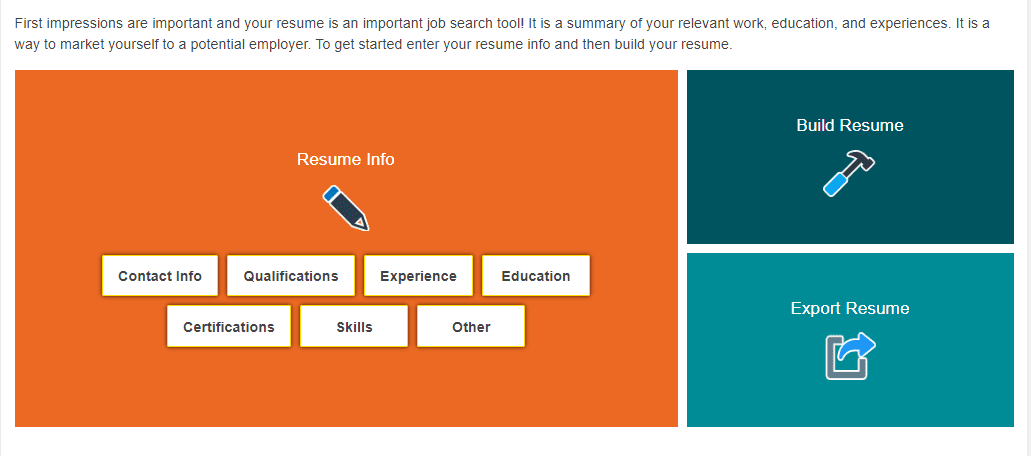myStrategic Compass: Employment
Resume
Learners complete a thorough job application data sheet that can then be transformed into two resume styles or the user can create a custom resume. Resumes can be exported to a PDF or Word document. Learners may also upload and save resumes created outside myStrategic Compass.
Job Searching
Through myStrategic Compass, learners can access the US National Labor Exchange, an online database of current job openings across the United States.
Job Success
This section contains skill-building content and activities to help users develop good work habits, improve themselves, deal with others and deal with problem situations.
Sorts
mSC sorts help users explore the world of work and education in the context of knowing who they are and what they want. Using mSC sorts, users apply what they know about themselves to choose factors that will help them identify content that is important to them and, hopefully, expand their options. There are five sorts available:
1. Occupation Sort
2. School Sort
3. Financial Aid Sort
4. SKILLS
5. Occupation Filter
Occupation Sort
Occupation Sort uses 28 factors, identified by career development professionals as highly useful in career decision making. It is a process-driven experience that applies career decision making and choice theory, and it is not strictly a Sort but a hybrid tool. Individuals can prioritize factors, create an acceptable range for each factor, and compromise. Once results are generated, users may also change their minds, learn why an occupation was eliminated from the list, and then generate new results. Occupation Sort is found under the Occupations tab.
School Sort
This sorting tool includes two sorting tools, the Undergraduate School Sort and the Graduate School Sort, both located under the Education tab. Undergraduate School Sort locates two-and four-year schools that match characteristics that a user identifies as important. Undergraduate School Sort uses several topics considered important in school choice. Users can search schools that offer any majors they wish to explore. Identifying the school that offers the major you desire can reduce transfer rates and education costs. Although all private career schools are included in State Schools, private career schools are not included in Undergraduate School Sort. The Graduate School Sort works much like Undergraduate School Sort. Graduate School Sort locates graduate schools that match characteristics an individual identifies as important. Graduate School Sort uses just five characteristics often considered important in school choice.
Financial Aid Sort
Financial Aid Sort locates local, regional, state, and national scholarships and grants that match characteristics an individual identifies as important. Financial Aid Sort uses ten sorting characteristics. It is recommended that users do multiple sorts. For example, sorts based upon the month the scholarship application is due or sorts based on specific majors of interest. The results of Financial Aid Sort are inclusive rather than exclusive; users' selections add items to their lists. (As recommended earlier, consider using the "Search" function in Financial Aid for shorter lists.) Users can elect to answer all characteristics to generate a more targeted list. Financial Aid Sort is found under the Education tab.
Skills
SKILLS is both an assessment and a sorting tool that helps users identify skill preferences then correlates these preferences to the skill requirements of CIS occupations, to Holland personality types and to occupation clusters, providing lists for cursory exploration and self-awareness. SKILLS is found under the Assessment tab. Users begin SKILLS by reflecting upon their achievements using a card sort or worksheet, then they select their five most satisfying skills, ten moderately satisfying skills, and 20 somewhat satisfying skills using the computer program. These skill preferences are correlated with the skill requirements of occupations. Users see a Summary Report and can then view their Holland Types, their top clusters, and their Top 30 occupations. Users can view the skill-coding of any occupation and compare that coding to their desired use of skills by clicking the eyeglasses icon. Users can also click Occ Select to begin SKILLS with the skill-coding of any occupation of interest, identifying occupations that use similar skills to the occupation of interest.
Occupation Filter
The Occupation Filter allows the user to sort through occupations on factors of importance: median wages, years of education required, and “green.” Lists can be organized by any factor and criteria can be changed once lists are viewed to modify results. Filter sorting is an instructional resource that quickly shows occupational characteristics for factors of importance for users.
© 1971-2018 University of Oregon. All rights reserved. Created by intoCareers, a unit of the University of Oregon.





